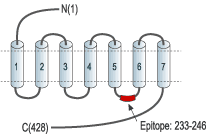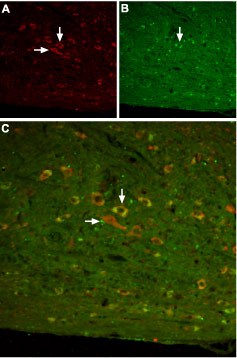Overview
- Peptide KVRSTTRRVRAPSC, corresponding to amino acid residues 233-246 of rat SSTR3 (Accession P30936). Intracellular, between transmembrane domains 5 and 6.

 Western blot analysis of rat brain lysate:1. Anti-Somatostatin Receptor Type 3 Antibody (#ASR-003), (1:200).
Western blot analysis of rat brain lysate:1. Anti-Somatostatin Receptor Type 3 Antibody (#ASR-003), (1:200).
2. Anti-Somatostatin Receptor Type 3 Antibody, preincubated with Somatostatin Receptor Type 3 Blocking Peptide (#BLP-SR003).
 Expression of SSTR3 in mouse cerebellumImmunohistochemical staining of mouse cerebellum with Anti-Somatostatin Receptor Type 3 Antibody (#ASR-003). A. SSTR3 appears in Purkinje cells (red, arrow points at an example). B. Staining of Purkinje nerve cells with mouse anti parvalbumin (a calcium binding protein, green). C. Confocal merge of SSTR3 and parvalbumin demonstrates the co-localization of these proteins in Purkinje cells (arrow points at a Purkinje cell pointed at in A and B).
Expression of SSTR3 in mouse cerebellumImmunohistochemical staining of mouse cerebellum with Anti-Somatostatin Receptor Type 3 Antibody (#ASR-003). A. SSTR3 appears in Purkinje cells (red, arrow points at an example). B. Staining of Purkinje nerve cells with mouse anti parvalbumin (a calcium binding protein, green). C. Confocal merge of SSTR3 and parvalbumin demonstrates the co-localization of these proteins in Purkinje cells (arrow points at a Purkinje cell pointed at in A and B).
- Patel, Y.C. (1999) Front. Neuroendocrinol. 20, 157.
- Weckbecker, G. et al. (2003) Nat. Rev. Drug Disc. 2, 999.
- Culler, M.D. et al. (2002) Ann. Endocrinol. (Paris) 63, 2S5.
- Corleto, V.D. et al. (2004) Dig. Liver Dis. 36, S8.
Somatostatin (SST) is a small cyclic peptide that was first identified as a powerful inhibitor of the secretion of various hormones including growth hormone (GH), thyroid-stimulating hormone (TSH) and prolactin from the pituitary, as well as practically every major hormone from the intestinal tract. SST consists of two major bioactive forms, SST-14 and the N-terminus extended peptide SST-28 that can be produced by a wide variety of neuroendocrine, inflammatory and immune cells. SST induces in target cells a variety of physiological functions that include nueromodulation, cell secretion, cell proliferation and smooth muscle contractility.
SST acts on its multiple cell targets via a family of six receptors that are originated form five genes: SSTR1, SSTR2a, SSTR2b, SSTRR3, SSTR4, SSTR5. The SSTRs are members of the G-protein coupled receptor superfamily and they modulate cell response via multiple second messenger systems such as inhibition of adenylate cyclase, modulation of conductance of ion channels and protein dephosphorylation.
SSTRs are expressed widely in both the brain and peripheral tissues but with receptor subtype variations between the different cell types. Thus, SSTR3 expression in the brain is primarily concentrated in the cerebellum with lesser expression in peripheral organs such as the spleen, the liver and the pituitary.
Strong SSTR expression has been detected in a variety of human tumors including pancreatic, breast, lung and prostate cancers. In fact, SST has been shown to inhibit the growth of various normal and tumor cells. On this basis several long lasting SST analogs have been developed and are being tested for use in several pathologies such as various cancers, acromegaly, immunoproliferative disorders, diabetic retinopathy, epilepsy and pain.
Application key:
Species reactivity key:
Alomone Labs is pleased to offer a highly specific antibody directed against a highly conserved epitope in the third intracellular loop of the rat SSTR3. Anti-Somatostatin Receptor Type 3 Antibody (#ASR-003) can be used in western blot analysis and immunohistochemistry applications. It has been designed to recognize SSTR3 from human, mouse, and rat samples.
Applications
Citations
- Mouse brain sections (1:300).
Lukomska, A. et al. (2020) Brain Struct. Funct. 225, 387.
